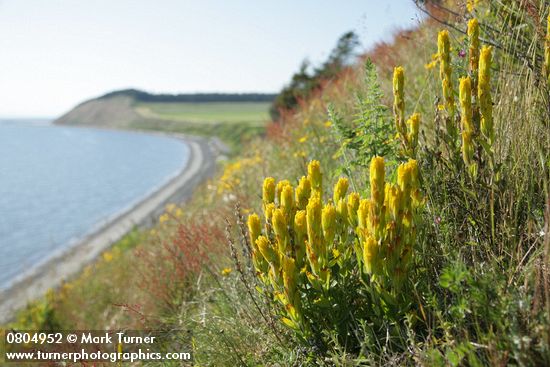Golden Paintbrush

Sometimes plants raise many questions when we find them in the field. Castilleja levisecta, golden paintbrush, is a rare species that is only found in a very small number of places and in some of those there are only a few plants. I visited one of those sites last week to make the photograph above and spent about an hour working with the plants on a windy late afternoon. The location is hazardous and not one I’d recommend visiting as the slope is steep and slippery. I almost wished for crampons and a belay as I carefully placed my feet to avoid damaging the habitat.
At this particular location golden paintbrush is quite prolific, but only within a small area on the bluff. Go just a short distance north or south and the plant is nowhere to be found. Why does it apparently thrive there and not elsewhere? The slope, which is rather sandy soil, is slowly eroding back away from the beach. How does the paintbrush deal with this natural force? Paintbrushes are hemiparisitic, forming a relationship with a host plant to help them extract nutrients from the soil. But they aren’t super picky about the host, growing with a number of grasses, Artemisia species, and Oregon sunshine. What is their preferred host here? There are both grasses and Oregon sunshine on the slope and I found golden paintbrush among both. I also found weedy introduced species like Rumex acetosella, sour dock, on the slope.
This area has had human influence a long time, by white settlers and by Native Americans before them. But the bluff is probably infrequently visited. Work is underway to reestablish golden paintbrush in other locations throughout its former range from seed collected in places like this, propagated in a greenhouse, and then planted out. There’s been some success getting the transplants to grow, but it’s a long slow process.

